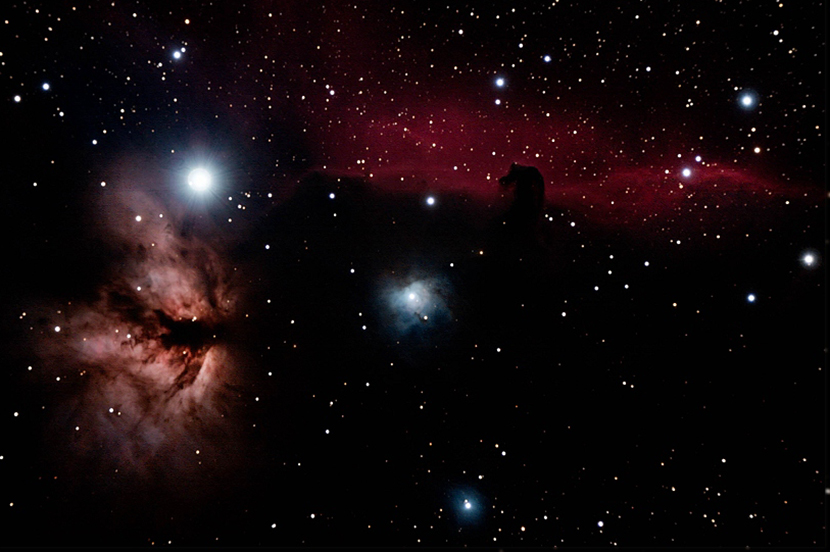
Flame and Horsehead Nebula
© 2015 Mike Stump
The Flame Nebula is part of the Orion Molecular Cloud Complex, a star-forming region that includes the famous Horsehead Nebula.
Explore Scientific ED127CF - Celestron AVX Mount - Canon EOS 6D
Michael Stump
The following was retrieved from Wikipedia, the free encyclopedia, at en.wikipedia.org/wiki/Flame_Nebula on November 21, 2016
The Flame Nebula, designated as NGC 2024 and Sh2-277, is an emission nebula in the constellation Orion. It is about 900 to 1,500 light-years away.
The bright star Alnitak (ζ Ori), the easternmost star in the Belt of Orion, shines energetic ultraviolet light into the Flame and this knocks electrons away from the great clouds of hydrogen gas that reside there. Much of the glow results when the electrons and ionized hydrogen recombine. Additional dark gas and dust lies in front of the bright part of the nebula and this is what causes the dark network that appears in the center of the glowing gas. The Flame Nebula is part of the Orion Molecular Cloud Complex, a star-forming region that includes the famous Horsehead Nebula.
At the center of the Flame Nebula is a cluster of newly formed stars, 86% of which have circumstellar disks. X-ray observations by the Chandra X-ray Observatory show several hundred young stars, out of an estimated population of 800 stars. X-ray and infrared images indicate that the youngest stars are concentrated near the center of the cluster."
The license terms of this written work from Wikipedia may be found at http://creativecommons.org/licenses/by-sa/3.0/
The following was retrieved from Wikipedia, the free encyclopedia, at en.wikipedia.org/wiki/Horsehead_Nebula on November 21, 2016
Horsehead Nebula
"The Horsehead Nebula (also known as Barnard 33) is a dark nebula in the constellation Orion. The nebula is located just to the south of the star Alnitak, which is farthest east on Orion's Belt, and is part of the much larger Orion Molecular Cloud Complex. The nebula was first recorded in 1888 by Scottish astronomer Williamina Fleming on photographic plate B2312 taken at the Harvard College Observatory. The Horsehead Nebula is approximately 1500 light years from Earth. It is one of the most identifiable nebulae because of the shape of its swirling cloud of dark dust and gases, which bears some resemblance to a horse's head when viewed from Earth."
The license terms of this written work from Wikipedia may be found at http://creativecommons.org/licenses/by-sa/3.0/
Outreach || Flagstaff || Photos || Articles || Observing Sites || Weather
Coordinated Universal Time || National Weather Service
info@coconinoastro.org

